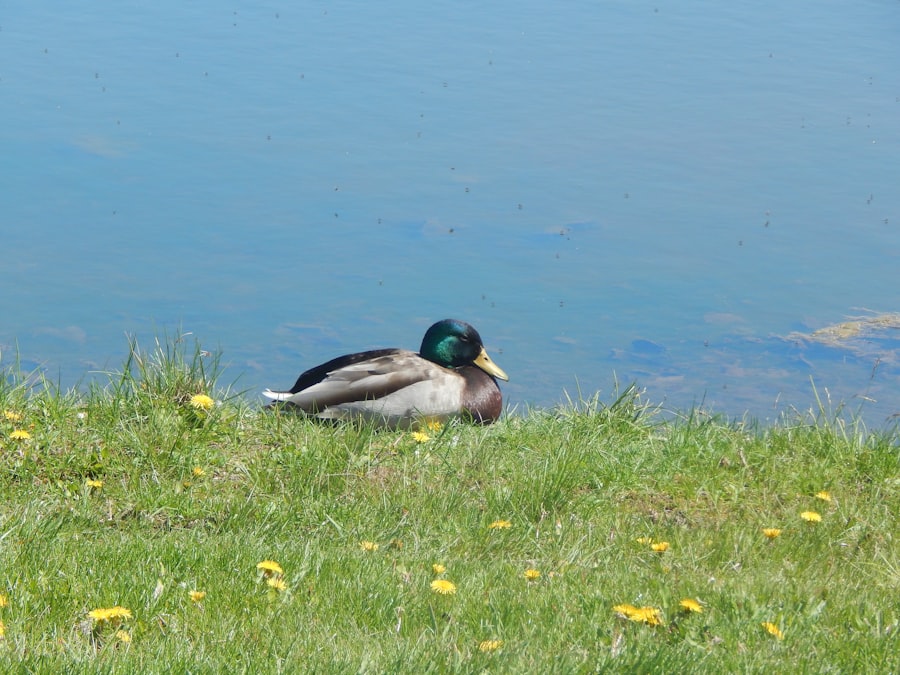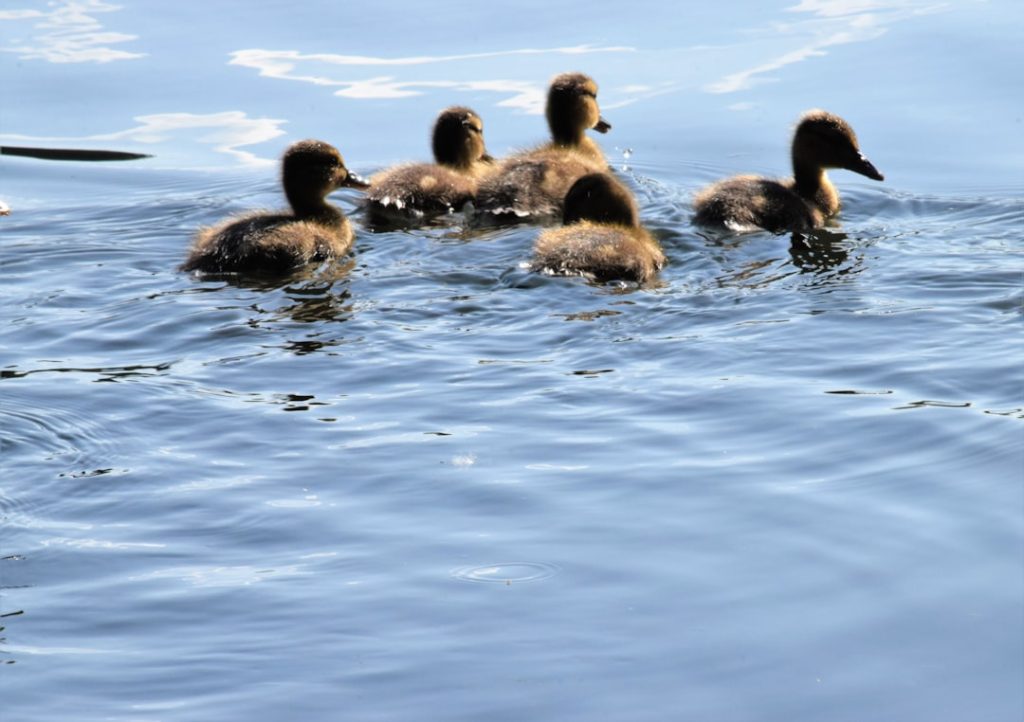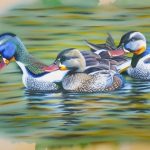Mallard ducks are a common species of wild duck found in North America, Europe, and Asia. They are known for their distinctive iridescent green heads, white neck ring, and chestnut-brown chest. Mallards are highly adaptable and can be found in a variety of habitats, including wetlands, marshes, lakes, and rivers. They are also known for their migratory behavior, with some populations traveling thousands of miles each year.
Mallard ducks are omnivorous and feed on a variety of foods, including aquatic plants, insects, and small fish. They are also known to forage in agricultural fields for grains and seeds. In the wild, mallards form monogamous pairs during the breeding season, with the male performing elaborate courtship displays to attract a mate. The female builds a nest on the ground near water and lays a clutch of 8-13 eggs. After an incubation period of about 28 days, the ducklings hatch and are cared for by the female until they are able to fend for themselves.
Mallard ducks are also popular among breeders and hobbyists due to their attractive plumage and gentle temperament. They are often used in crossbreeding programs to produce hybrid ducks with desirable traits. Understanding the natural behavior and habitat of mallard ducks is essential for successful breeding and raising of ducklings.
Table of Contents
Key Takeaways
- Mallard ducks are a common breed of domestic duck with distinct coloring and behavior
- When selecting breeding stock, look for healthy, active ducks with good body conformation and strong genetics
- Create a breeding environment with a secure, predator-proof enclosure and access to clean water and nutritious feed
- The breeding and incubation process involves providing a suitable nesting area and ensuring proper temperature and humidity levels
- Care for ducklings by providing a warm, dry brooding area, balanced nutrition, and regular monitoring for any health issues
- Health and disease management for ducklings includes vaccination, parasite control, and prompt treatment of any illnesses
- Decide whether to sell or keep ducklings based on your breeding goals and the demand for ducklings in your area
Selecting Breeding Stock
When selecting breeding stock for mallard ducks, it is important to choose healthy, genetically diverse birds with desirable traits. Look for ducks with vibrant plumage, strong legs, and a well-proportioned body. Avoid birds with deformities or genetic defects that could be passed on to their offspring. It is also important to select ducks that exhibit good maternal instincts and are capable of caring for their young.
When choosing breeding stock, consider the age and reproductive history of the ducks. Younger ducks may have better fertility and reproductive success, while older ducks may have decreased fertility and egg production. It is also important to consider the genetic diversity of the breeding stock to avoid inbreeding and maintain a healthy population.
It is recommended to purchase breeding stock from reputable breeders or hatcheries that can provide documentation of the birds’ health and genetic background. This will help ensure that you are starting with a strong foundation for your breeding program. By carefully selecting breeding stock, you can improve the overall quality and productivity of your duck flock.
Setting Up a Breeding Environment
Creating a suitable breeding environment is essential for the health and well-being of mallard ducks. The breeding area should provide ample space for the ducks to forage, swim, and nest. A pond or shallow water source is ideal for mallard ducks, as they are waterfowl and enjoy swimming and dabbling in the water.
The nesting area should be located near water and provide protection from predators. A simple nest box or sheltered area with straw or grass can provide a safe and comfortable space for the female to lay her eggs and care for her ducklings. It is important to provide nesting material such as straw or grass to encourage the female to build a nest.
In addition to a suitable nesting area, it is important to provide a balanced diet for the breeding ducks. A diet high in protein and essential nutrients will support egg production and overall reproductive health. Fresh water should also be readily available at all times.
Finally, it is important to monitor the breeding environment for signs of stress, disease, or predation. Regularly inspect the nesting area and provide protection from predators such as raccoons, foxes, and birds of prey. By creating a safe and comfortable breeding environment, you can support the natural reproductive behaviors of mallard ducks.
Breeding and Incubation Process
Breeding mallard ducks typically occurs in the spring when daylight hours increase and temperatures rise. During this time, male mallards perform elaborate courtship displays to attract a mate. Once a pair has formed, the female will begin to build a nest near water using grasses, reeds, and other vegetation.
The female will lay one egg per day until she has laid a clutch of 8-13 eggs. She will then begin incubating the eggs by sitting on them to keep them warm. The incubation period for mallard eggs is approximately 28 days. During this time, it is important to provide the female with a quiet and undisturbed environment to ensure successful incubation.
If you are breeding mallard ducks in a controlled environment, you may choose to collect the eggs for artificial incubation. This involves placing the eggs in an incubator set at the appropriate temperature and humidity levels. It is important to regularly monitor the eggs for signs of development and adjust the incubator settings as needed.
Once the eggs have hatched, the ducklings will need to be kept warm and dry in a brooder box or similar enclosure. Provide them with access to water for swimming and drinking, as well as a balanced diet high in protein to support their growth and development. By understanding the breeding and incubation process of mallard ducks, you can support successful reproduction and raise healthy ducklings.
Caring for Ducklings
Caring for mallard ducklings requires attention to their basic needs for warmth, food, water, and protection. Ducklings should be kept in a warm brooder box with access to a heat source such as a heat lamp or heating pad. The temperature should be gradually reduced as the ducklings grow feathers and become more independent.
Provide ducklings with access to clean water for drinking and swimming. Shallow water dishes or tubs can be used for ducklings to splash around in and clean themselves. It is important to monitor water quality and cleanliness to prevent disease and contamination.
A balanced diet high in protein is essential for the growth and development of ducklings. Commercial duck starter feed or crumbles can provide essential nutrients for young ducklings. It is important to provide fresh feed daily and monitor their growth and development.
As ducklings grow, they will begin to explore their environment and exhibit natural behaviors such as dabbling in water and foraging for food. Provide them with ample space to move around and explore while ensuring their safety from predators.
By providing proper care and attention to ducklings, you can support their healthy growth and development into mature ducks.
Health and Disease Management

Maintaining the health of mallard ducks requires regular monitoring for signs of illness or disease. Common health issues in ducks include respiratory infections, parasites, nutritional deficiencies, and injuries. It is important to observe your ducks daily for any changes in behavior, appetite, or appearance that may indicate illness.
Preventative measures such as vaccination, parasite control, and biosecurity can help reduce the risk of disease in your duck flock. Consult with a veterinarian or poultry health expert to develop a health management plan for your ducks.
Proper nutrition is essential for maintaining the health of mallard ducks. A balanced diet high in protein, vitamins, and minerals will support overall health and immune function. Provide access to clean water at all times to prevent dehydration and support digestion.
Regular cleaning of the duck housing area is important for preventing disease transmission and maintaining a clean environment for your ducks. Remove soiled bedding, feces, and food waste regularly to prevent the buildup of bacteria and parasites.
If you suspect that your ducks are ill or showing signs of disease, it is important to seek veterinary care promptly. Early intervention can help prevent the spread of disease and improve the chances of recovery for affected ducks.
By implementing proactive health management practices, you can support the overall well-being of your mallard ducks.
Selling or Keeping Ducklings
Once your mallard ducklings have matured into healthy adults, you may choose to sell them as breeding stock or keep them as part of your flock. If you plan to sell ducklings, it is important to find reputable buyers who are interested in raising ducks for egg production, meat production, or ornamental purposes.
When selling ducklings, provide potential buyers with information about the breed, age, health status, and genetic background of the ducks. This will help ensure that they are well-informed about their purchase and can provide proper care for the ducklings.
If you choose to keep ducklings as part of your flock, consider their housing needs as they mature into adult ducks. Provide ample space for them to move around, access to water for swimming, and a balanced diet to support their overall health.
Breeding mallard ducks can be a rewarding experience that allows you to raise healthy ducklings and contribute to conservation efforts for this iconic species. Whether you choose to sell or keep your ducklings, it is important to prioritize their well-being and provide them with a safe and comfortable environment.
In conclusion, understanding mallard ducks’ natural behavior, selecting breeding stock carefully, creating a suitable breeding environment, managing the breeding process effectively, caring for ducklings attentively, maintaining their health diligently, and making informed decisions about selling or keeping ducklings are all essential aspects of successful mallard duck breeding. By following these guidelines, you can contribute to the conservation of this iconic species while enjoying the rewards of raising healthy ducklings.
If you’re interested in breeding mallard ducks, you may also want to consider the importance of providing a suitable environment for your poultry. Check out this informative article on “What Kind of Coop is Best for Chickens” from Poultry Wizard. It offers valuable insights into creating a comfortable and secure space for your birds, which can also be beneficial for breeding ducks. (source)
FAQs
What is the breeding season for mallard ducks?
The breeding season for mallard ducks typically occurs in the spring and early summer, with peak breeding activity taking place from March to June.
How do mallard ducks choose a mate?
Mallard ducks engage in courtship displays, with males performing various behaviors to attract females, such as head bobbing, tail wagging, and vocalizations. Once a pair bond is formed, they will mate and the female will begin to build a nest.
Where do mallard ducks build their nests?
Mallard ducks build their nests on the ground, typically in grassy areas near water, such as marshes, ponds, or streams. The female constructs the nest using grasses, reeds, and other plant materials, and lines it with down feathers.
How many eggs do mallard ducks lay?
Mallard ducks typically lay a clutch of 8-13 eggs, with one egg being laid each day until the clutch is complete. The female will then begin incubating the eggs, which takes about 26-30 days for them to hatch.
What do mallard ducklings eat?
Mallard ducklings feed on a diet of insects, small crustaceans, and aquatic plants. They will also consume small fish and amphibians if they are available in their environment. The mother duck will lead her ducklings to suitable foraging areas and provide them with guidance on what to eat.
Meet Walter, the feathered-friend fanatic of Florida! Nestled in the sunshine state, Walter struts through life with his feathered companions, clucking his way to happiness. With a coop that’s fancier than a five-star hotel, he’s the Don Juan of the chicken world. When he’s not teaching his hens to do the cha-cha, you’ll find him in a heated debate with his prized rooster, Sir Clucks-a-Lot. Walter’s poultry passion is no yolk; he’s the sunny-side-up guy you never knew you needed in your flock of friends!







